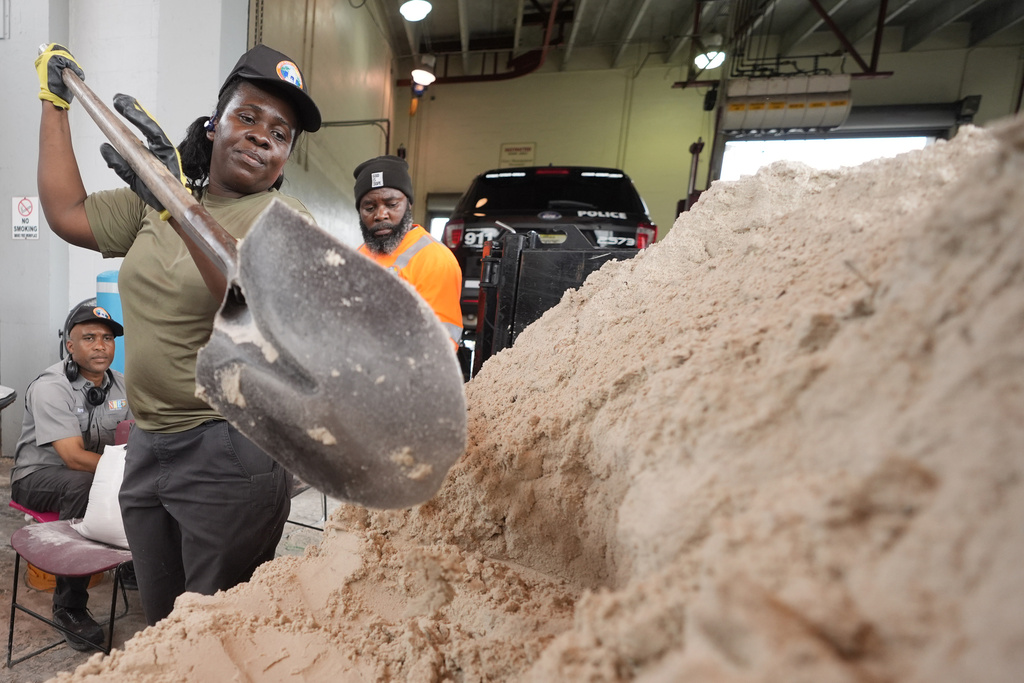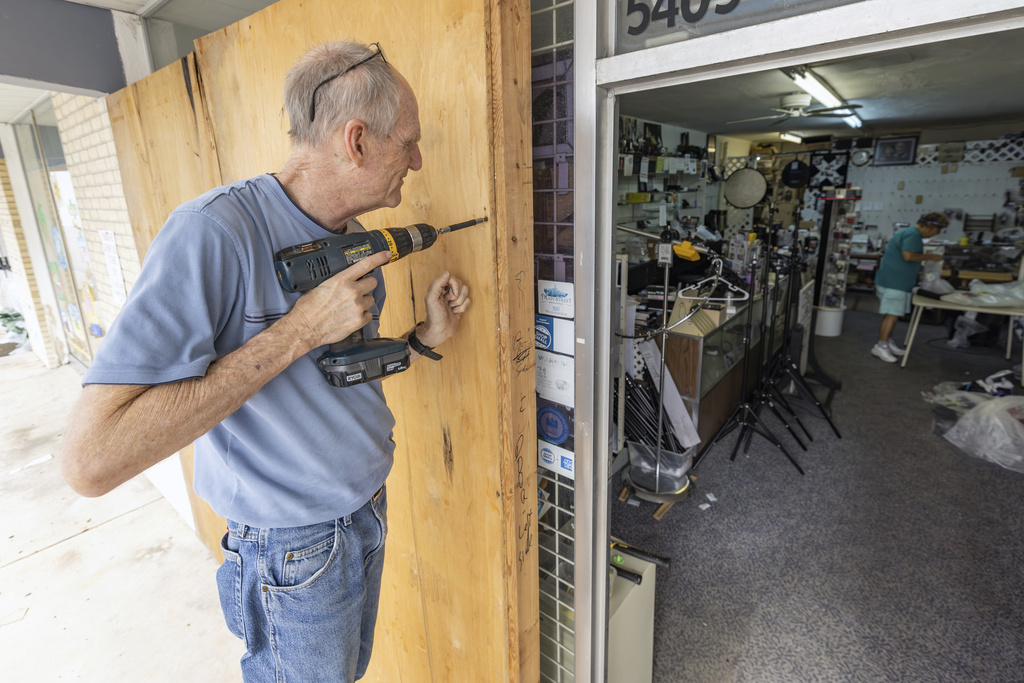Thousands Flee Tampa Bay as Hurricane Milton Targets Florida \ Newslooks \ Washington DC \ Mary Sidiqi \ Evening Edition \ Thousands of residents fled the Tampa Bay region as Hurricane Milton, a powerful Category 4 storm, threatened a rare direct hit on Florida’s Gulf Coast. Crews worked tirelessly to clear debris from Hurricane Helene to prevent further destruction. Governor Ron DeSantis issued evacuation orders, while emergency officials warned of dangerous storm surges and winds. Hurricane Milton could bring life-threatening conditions, marking the worst storm in the region in a century.

Hurricane Milton Approaches Tampa Bay: Quick Looks
- Hurricane Milton is expected to make landfall near Tampa Bay as a Category 4 storm, with 155 mph winds.
- Over 3.3 million people are in the path of the storm, with 5.9 million under mandatory evacuation orders.
- Officials are clearing debris from Hurricane Helene to prevent deadly projectiles.
- Governor Ron DeSantis reassured residents there would be enough fuel for evacuations.
- FEMA has deployed 900 staff to the region, stocking emergency supplies and urging residents to heed evacuation warnings.
Deep Look:
As Hurricane Milton barrels toward Florida’s Gulf Coast, thousands of residents in the Tampa Bay region are evacuating ahead of what could be a once-in-a-century storm. Milton, a massive Category 4 hurricane, is expected to make landfall late Wednesday night, bringing with it life-threatening storm surges, devastating winds, and heavy rain. This is the Tampa metro area’s first direct threat from a major hurricane in generations, making the situation even more dire for the area’s 3.3 million residents.
Tampa Prepares for Historic Hurricane Impact
Preparation efforts across Tampa Bay and surrounding counties have been intense, as the region braces for a storm that officials fear will hit with unprecedented force. Crews rushed to clear away debris left by Hurricane Helene, which struck just weeks earlier, to prevent furniture, appliances, and other waterlogged wreckage from becoming deadly projectiles as Hurricane Milton approaches.
In Clearwater Beach, Nick Szabo spent his day hauling away piles of damaged mattresses, couches, and drywall that had been left on the streets after Helene. “All this crap is going to be missiles,” Szabo said. “It’s like a spear coming at you.”
Governor Ron DeSantis emphasized the urgency of the situation during a press conference. He confirmed that the state had deployed over 300 dump trucks to clear 1,300 loads of debris across 11 counties under evacuation orders. The storm is forecasted to cause dangerous storm surges that could reach up to 15 feet in some areas, with winds currently near 155 mph.
Craig Fugate, a former FEMA director and Florida’s ex-emergency management chief, issued a stark warning: “Today’s the last day to get ready. This is bringing everything.”
Evacuation Efforts and Warnings
As of Tuesday, the Florida Highway Patrol reported heavy traffic northbound and eastbound as tens of thousands of evacuees fled the region. Governor DeSantis urged residents to evacuate, emphasizing that they do not need to travel far to find safety. “You do not have to evacuate hundreds of miles away,” DeSantis assured. “You have options.”
Despite the state’s warnings, many residents remained hesitant to leave. In Riverview, just south of Tampa, drivers lined up for fuel, with some expressing their intent to stay. Martin Oakes of Apollo Beach said he and his family planned to ride out the storm. “We got shutters up. The house is all ready. So this is sort of the last piece of the puzzle,” Oakes said.
Others, like Ralph Douglas from Ruskin, worried about potential issues returning home after the storm due to debris or fuel shortages. “Where I’m at right now, I don’t think I need to evacuate,” Douglas said, even as experts warned of the storm’s unpredictable nature.
Hurricane Milton’s Expected Path and Impact
While Hurricane Milton weakened slightly after reaching Category 5 status on Monday, it remains a highly dangerous Category 4 storm. The National Hurricane Center forecasts that Milton could dump as much as 18 inches of rain across central Florida, potentially triggering flash floods. The storm is expected to move across Florida and then re-enter the Atlantic Ocean. Fortunately, this track would largely spare states further north that are still recovering from Hurricane Helene, which killed 230 people from Florida to the Carolinas.
Tampa Bay has not seen a direct hit from a hurricane since 1921, and local officials are concerned that this streak of good luck may finally be over. Tampa Mayor Jane Castor has been issuing increasingly dire warnings about the storm’s potential destruction. “A 15-foot surge could swallow an entire house,” she said grimly. “If you’re in it, that’s the coffin that you’re in.”
FEMA and Federal Response
Recognizing the severity of the threat posed by Hurricane Milton, President Joe Biden approved an emergency declaration for Florida on Tuesday. The White House also confirmed that Biden would postpone his scheduled trips to Germany and Angola to monitor the storm’s developments closely.
“This could be the worst storm to hit Florida in over a century,” Biden told reporters. “God willing, it won’t be. But that’s what it’s looking like right now.”
Federal Emergency Management Agency (FEMA) administrator Deanne Criswell echoed the president’s concerns and urged residents to follow evacuation orders. “I need people to listen to their local officials to get out of harm’s way,” she said. “People don’t need to move far. They just need to move inland.”
FEMA has positioned nearly 900 staff members in the region and has stocked two staging areas with 20 million meals and 40 million liters of water. Criswell highlighted the agency’s readiness to respond to post-storm needs but stressed the importance of personal safety and preparedness.
Lingering Challenges from Hurricane Helene
In addition to the preparations for Hurricane Milton, the region is still reeling from the effects of Hurricane Helene. Many areas are strewn with debris, and overwhelmed contractors have struggled to keep up with removal efforts. The Florida Department of Emergency Management has deployed crews to clear streets and reduce the risk of flying debris during Milton’s powerful winds.
One resident of Fort Myers Beach, which was devastated by Helene’s 15-foot storm surge two years ago, expressed frustration over the frequency and increasing intensity of hurricanes. “It is getting old, and every year it seems that it is getting worse,” said David Jalving. Jalving’s family had just finished repairs on their home after it sustained extensive damage from Hurricane Ian in 2022. Now, as Hurricane Milton approaches, he is considering leaving Florida for good. “I can’t deal with another one,” he said.
Mexico’s Brush with Milton
As Hurricane Milton advanced toward Florida, its outer bands brushed the Yucatan Peninsula, causing minor damage in parts of Mexico. Authorities reported power outages and structural damage along the coast, but there were no reports of casualties. Yucatan Governor Joaquín Díaz confirmed that while trees, power lines, and some structures were knocked down, the region was largely spared from severe impacts. The hurricane stayed offshore, and residents were able to return to normal life relatively quickly.
As Florida braces for the worst of Hurricane Milton’s impact, emergency crews remain on high alert, and residents across the state have a few final hours to prepare for the potentially historic storm.
Thousands Flee Tampa Thousands Flee Tampa Thousands Flee Tampa







